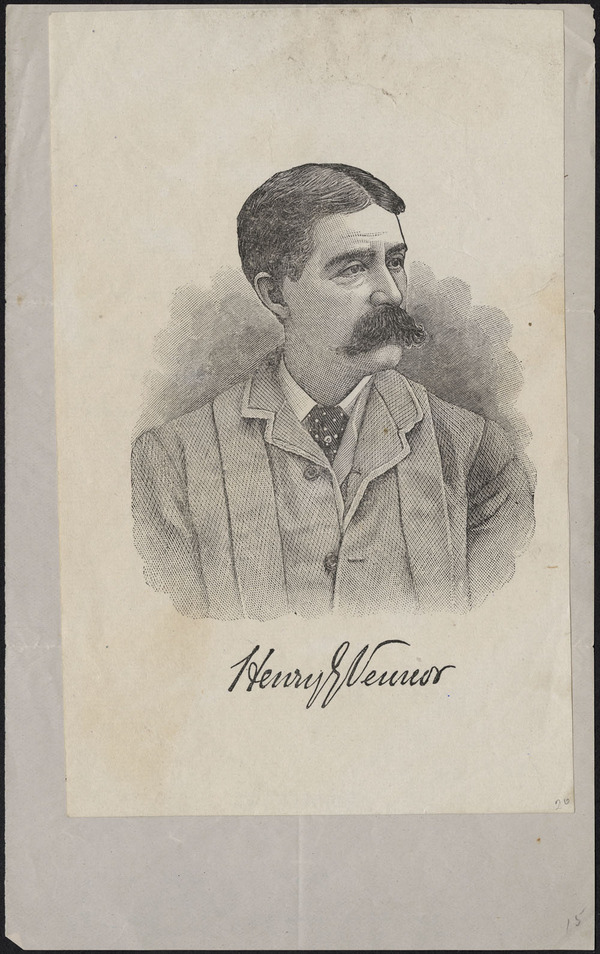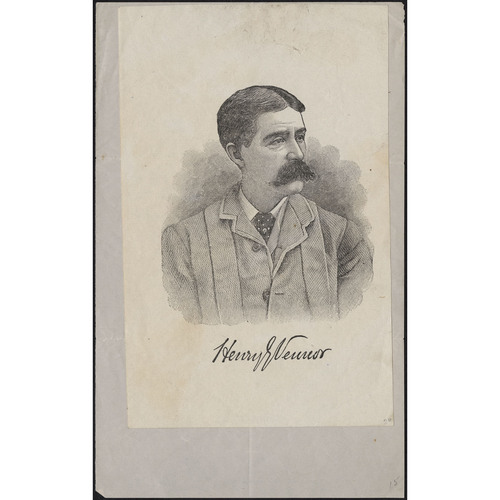VENNOR, HENRY GEORGE, geologist, ornithologist, and weather prophet; b. 30 Dec. 1840 in Montreal, Lower Canada, son of Henry Vennor, a hardware merchant, and Marion Paterson; d. 8 June 1884 at Montreal.
Henry George Vennor received his early education at Philips School and the High School of Montreal, where he developed a keen interest in natural sciences. While still a schoolboy he assembled a collection, preserved in alcohol, of local snakes and other reptiles, which gained him honourable mention at a provincial exhibition. In the late 1850s he began attending McGill College, where he studied geology, mineralogy, zoology, and civil engineering under such prominent scientists as John William Dawson* and Thomas Sterry Hunt*. Before he graduated with honours in 1860, Vennor made a large collection of the fossils of Montreal Island, wrote several papers on local bird life for the Canadian Naturalist and Geologist of Montreal, and commenced a review of eastern Canadian song birds which was published in the British American Magazine of Toronto in 1864. After graduation he spent five years with the Montreal mercantile firm of John Frothingham* and William Workman*, and continued to collect fossils and birds. In 1865 Vennor accepted an apprenticeship under Sir William Edmond Logan*, head of the Geological Survey of Canada, whom he aided in a survey of Manitoulin Island, Canada West. The following year he was appointed a full member of the survey, and for the next 15 years worked in the region of southeastern Ontario and Pontiac County, Que., establishing basic distributions of various rock types and describing in detail their economic mineral and metal deposits. To complete these tasks satisfactorily, Vennor had first to prepare adequate topographic base maps, an onerous job which he executed with patience and skill.
During 1866 Vennor was closely associated with the first recorded identification of gold in the Precambrian rocks of Ontario, at a small metals mine in Madoc Township, Hastings County. To his credit, Vennor played down the discovery’s importance and foretold a quick collapse of the resulting gold-rush – a prediction borne out the following year. He remained a keen student of mining and mineral deposits, and did much to promote the interests of local operators. In 1872, for instance, he directed attention to the phosphate deposits of Ottawa County, Que., where a number of mines were subsequently worked at considerable profit during the phosphate boom of the 1880s.
In 1867 Vennor had published a paper on the vital question of the stratigraphy of the Precambrian Shield in the Hastings County area in the Quarterly Journal of the Geological Society of London, to which prestigious body he was elected in 1870. Apart from a few short papers, however, he wrote no more for scientific journals, his major contributions appearing instead in seven reports of the Geological Survey of Canada. In 1876 he also published Our birds of prey, a volume profusely illustrated with William Notman*’s pasted-in photographic plates of stuffed raptors. The venture proved a commercial failure and Vennor was to complain that the book was “too expensive for Canada.”
In 1881 Vennor resigned from the Geological Survey because his dealings in phosphate mining lands would create a conflict of interest which parliament was shortly to deny to officers of the survey. Vennor apparently also had serious disputes with Alfred Richard Cecil Selwyn*, Logan’s successor at the survey, over working conditions and his reports (the results of Vennor’s last five years of survey work were never published). Probably the advancement of better-trained younger men, such as George Mercer Dawson*, rankled, as it did with some of his colleagues. Vennor had done well with his broad natural sciences training in a region of exceedingly complex geology (still challenging today’s earth scientists) and he had paid close attention to a main survey objective – economic development through mining. He maintained his interest by opening a consulting office in Montreal at this time.
Vennor’s work led him outdoors most of the year, and not surprisingly he was a keen student of the weather and the problems of its prediction. In the fall of 1875, from a “feeling in his bones,” he correctly predicted in local newspapers a green Christmas and a muddy New Year’s Day for Montreal. The prediction aroused great public interest and led him to publish in 1877 the first Vennor’s almanac. By gathering data on weather patterns in previous years and comparing the weather of the existing year against past activity, Vennor claimed to have discovered a “law of recurrences” which enabled him accurately to predict what weather would occur. The almanacs, issued annually, were widely read and acclaimed throughout eastern North America and grew so successful that in 1881 a separate American edition was issued, supplemented in 1882 and part of 1883 by the monthly Vennor’s weather bulletin.
Vennor continued to work on his almanac until his death in June 1884, at which time Walter H. Smith took it up, supplementing Vennor’s theories with his own system of “astrometeorology.” In the 1885 edition of the almanac Smith claimed that Vennor was survived by a wife and three children, although other obituaries make no mention of his family. Indeed, his death was not noted in print by the scientific world. Vennor received front page tributes from the New York Times and the Montreal Gazette, however, the latter referring to him as “a thoughtful student of science, whose work will live after him,” a fitting tribute to this enigmatic man of science.
Henry George Vennor was the author of “On the feathered songsters of the island of Montreal,” British American Magazine (Toronto), 2 (1864): 606–10. He published in the Canadian Naturalist and Geologist “Notes on birds wintering in and around Montreal; from observations taken during the winters of 1856–57–58–59–60,” 5 (1860): 425–30; “A short review of the sylviadæ or wood-warblers found in the vicinity of Montreal,” 6 (1861): 349–62; “Cave in limestone near Montreal,” new ser., 1 (1864): 14–16; “Ascending section of Laurentian rocks in the county of Hastings, Canada West,” new ser., 3 (1868): 310–11, reprinted from Geological Soc. of London, Quarterly Journal (London), 23 (1867), pt.i, 256–57; and “Notes on some of the galena or sulphuret of lead deposits connected with the Laurentian rocks of Ontario,” new ser., 7 (1875): 455–62. Vennor published “Report on the geology and economic minerals of parts of Hastings, Addington, and Peterborough counties” in the Geological Survey of Canada, Report of progress for 1866–69 (Montreal, 1870), 143–71; “Abstract of a report on the geology of parts of the counties of Frontenac, Leeds, and Lanark, Ont.,” Report . . . for 1870–71 (Ottawa, 1872), 309–15; “Progress report of explorations and surveys in the counties of Leeds, Frontenac, and Lanark, with notes on the gold of Marmora, with assays by B. J. Harrington,” Report . . . for 1871–72 (Montreal, 1872), 120–41; “Report of explorations and surveys in the counties of Addington, Frontenac, Leeds, and Lanark (Ontario),” Report . . . for 1872–73 (Montreal, 1873), 136–79; “Report of explorations and surveys in Frontenac, Leeds, and Lanark counties, with notes on the plumbago of Buckingham, and apatite of Templeton and Portland townships, Ottawa Co.,” Report . . . for 1873–74 (Montreal, 1874), 103–46; “Progress report of explorations and surveys in the rear portions of Frontenac and Lanark counties, together with notes of some of the economic minerals of Ontario,” Report . . . for 1874–75 ([Montreal], 1876), 105–65; and “Progress report of explorations and surveys made during the years 1875 and 1876 in the counties of Renfrew, Pontiac, and Ottawa, together with additional notes on the iron ores, apatite, and plumbago deposits of Ottawa County,” Report . . . for 1876–77 ([Montreal], 1878), 244–320. In American journals he published “Archæan of Canada,” American Journal of Science and Arts (New Haven, Conn.), 3rd ser., 14 (July–December 1877): 313–16, and “Phosphates in Canada,” Engineering and Mining Journal (New York), 33 (January–June 1882): 69. Vennor’s other works are Our birds of prey, or the eagles, hawks and owls of Canada (Montreal, 1876), Vennor’s almanac (Montreal), 1877–85, and Vennor’s weather bulletin (Montreal), 1882–83.
AC, État civil, Congrégationalists, Emmanuel Church (Montreal), 10 June 1884. ANQ-M, État civil, Congrégationalists, Zion Church (Montreal), 20 May 1841. McGill Univ. Libraries (Montreal), Blacker Wood Library, H. G. Vennor papers. Examiner (Charlottetown), 14 June 1884. Gazette (Montreal), 9 June 1884. New York Times, 9 June 1884. Appleton’s cyclopædia of American biography, ed. J. G. Wilson and John Fiske (7v., New York, 1887–1900), VI: 276–77. Dominion annual register, 1879–84. Zaslow, Reading the rocks.
Cite This Article
P. R. Eakins, “VENNOR, HENRY GEORGE,” in Dictionary of Canadian Biography, vol. 11, University of Toronto/Université Laval, 2003–, accessed January 23, 2025, https://www.biographi.ca/en/bio/vennor_henry_george_11E.html.
The citation above shows the format for footnotes and endnotes according to the Chicago manual of style (16th edition). Information to be used in other citation formats:
| Permalink: | https://www.biographi.ca/en/bio/vennor_henry_george_11E.html |
| Author of Article: | P. R. Eakins |
| Title of Article: | VENNOR, HENRY GEORGE |
| Publication Name: | Dictionary of Canadian Biography, vol. 11 |
| Publisher: | University of Toronto/Université Laval |
| Year of revision: | 1982 |
| Access Date: | January 23, 2025 |




